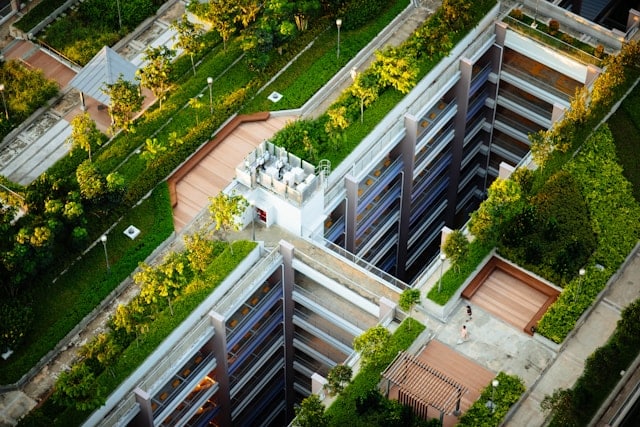How to Design an Energy-Efficient Roof Garden with a Cooling Effect for Your Home?

In our modern world, creating energy-efficient homes is not just a trend, it’s a necessity. With the increasing effects of climate change and the rising costs of energy, homeowners are looking for innovative ways to reduce their carbon footprint while also saving on their energy bills. One such method that’s gaining popularity these days is the creation of roof gardens. Not only do these green rooftops improve the aesthetics of a building, but they also provide numerous environmental and energy-saving benefits. In this article, we’ll walk you through the steps on how to create an energy-efficient roof garden that boasts a cooling effect for your home.
Choosing the Right Green Roof Design
When planning for a green roof, the appropriate design plays a crucial role in maximizing its energy efficiency. Green roofs can be categorized into two types: intensive and extensive. Intensive green roofs often mimic traditional gardens, complete with trees, shrubs, and even water features. They are heavier and require more maintenance, but also offer more opportunities for biodiversity. Extensive green roofs, on the other hand, are lighter and require less upkeep. They typically consist of a thin layer of soil and low-growing plants, such as mosses and grasses.
A lire en complément : What Are the Most Resilient Groundcover Plants for a Shady Courtyard?
To achieve a cooling effect, consider incorporating both types into your design. The shade from trees in the intensive section will block the sun’s rays, while the extensive section will absorb heat. This combination not only creates a more diverse landscape, but it also maximizes the roof’s cooling potential.
Using the Right Plants
The type of plants you choose for your roof garden can greatly influence its energy efficiency and cooling capabilities. Choose species that thrive in your local climate to ensure their survival and reduce the need for watering. Consider drought-tolerant plants for areas with less rainfall, and water-loving plants for areas with more precipitation.
Dans le meme genre : What’s the Best Way to Install Eco-Friendly Insulation in a Period Attic?
For a cooling effect, select plants with high transpiration rates. Transpiration is the process by which water is carried through plants from roots to small pores on the underside of leaves, where it changes to vapor and is released to the atmosphere. This process cools the air around the plants, creating a natural air conditioning effect.
Aside from cooling your home, these plants also improve air quality by absorbing harmful pollutants and releasing oxygen.
Incorporating Shade Features
Incorporating shade features into your roof garden design is another effective way to cool your home. Shade will not only protect your plants from the scorching sun, but it will also prevent your roof from absorbing too much heat.
Consider incorporating features like pergolas, shade sails, or even trees. These items will cast shadows on your roof, providing respite from the sun’s rays and reducing the temperature of your roof.
Remember, the goal is to create a balance. Too much shade can inhibit plant growth, while too little won’t provide adequate cooling. Collaborate with a professional landscape designer to strike the right balance.
Installing Cool Roofs
While incorporating a roof garden can significantly reduce your home’s heat absorption, installing a cool roof can further enhance this effect. Cool roofs are specially designed to reflect more sunlight and absorb less heat than standard roofs.
They are typically made from highly reflective type of paint, a sheet covering, or highly reflective tiles or shingles. When combined with a green roof, cool roofs can dramatically reduce your home’s energy consumption, especially during the hot summer months.
Implementing Energy-Efficient Windows
Lastly, don’t forget about your windows. They play a crucial role in maintaining a home’s temperature. Energy-efficient windows are designed to prevent your conditioned air from escaping your home. Utilizing these windows will complement your energy-efficient green roof by preventing heat gain or loss.
To further enhance their efficiency, consider installing window shades or awnings. These can prevent the sun’s rays from entering your home, reducing your need for air conditioning.
Designing an energy-efficient roof garden with a cooling effect involves careful planning and consideration. From choosing the right design and plants to incorporating shade features, installing cool roofs, and implementing energy-efficient windows, each step contributes to the overall efficiency of your home. With this guide, you’re well on your way to creating a beautiful, green, and energy-efficient haven.
Adding the Finishing Touches: Irrigation System, Drainage and Additional Features
Once you have chosen your garden design, plants, and shade features, it’s time to consider the finishing touches. These include the irrigation system, the drainage system, and additional features that add beauty and functionality to your roof garden.
An efficient irrigation system is vital to keep your plants healthy and thriving, especially during dry periods. Drip irrigation systems, which deliver water directly to the plant roots, can be an excellent choice for a rooftop garden. They conserve water, reduce evaporation, and prevent overwatering.
A well-designed drainage system is equally important. A good drainage system prevents waterlogging, protects the roof structure, and maintains the health of your plants. Green roofs usually incorporate a waterproof layer, a root barrier, a drainage layer, and a filter fabric on top of the roof structure.
Additionally, consider incorporating a rainwater harvesting system. This will allow you to collect and store rainwater for irrigation, further boosting your home’s energy efficiency and reducing your water bills.
Installing raised beds, trellises, and benches can also add aesthetic value to your roof garden. Raised beds can help protect your roof surface and make gardening easier on the back. Trellises are great for climbing plants and can provide extra shade, while benches offer a comfortable place to relax and enjoy your garden.
Conclusion: The Benefits of an Energy-Efficient Roof Garden
Creating an energy-efficient roof garden is not just about saving on energy costs – it’s also about creating a healthier environment for you and your family. Green roofs, by reducing heat islands and air pollution, can significantly improve the air quality around your home.
Roof gardens also provide several psychological benefits. Being surrounded by greenery can reduce stress, improve mood, and enhance overall well-being. Moreover, a roof garden can provide a serene space for relaxation, meditation, or even social gatherings.
A well-designed, energy-efficient roof garden can drastically reduce your air conditioning use and energy bills, particularly during the hot summer months. However, remember that it involves an upfront investment. You may need to hire professionals for the installation and spend on materials and plants. Nevertheless, the long-term benefits and savings will make it all worthwhile.
So, go ahead and make your home more sustainable and beautiful with a roof garden! Your effort will not only benefit your household but also contribute to a healthier planet.
Remember, every small step towards reducing our carbon footprint and creating more sustainable homes counts. And an energy-efficient roof garden is one of the most effective steps you can take.
In conclusion, with careful planning and the right choices, you can create an energy-efficient roof garden that offers a cooling effect, boosts your home’s energy efficiency, and provides a beautiful, serene space to enjoy. Happy gardening!
